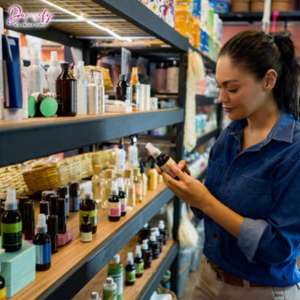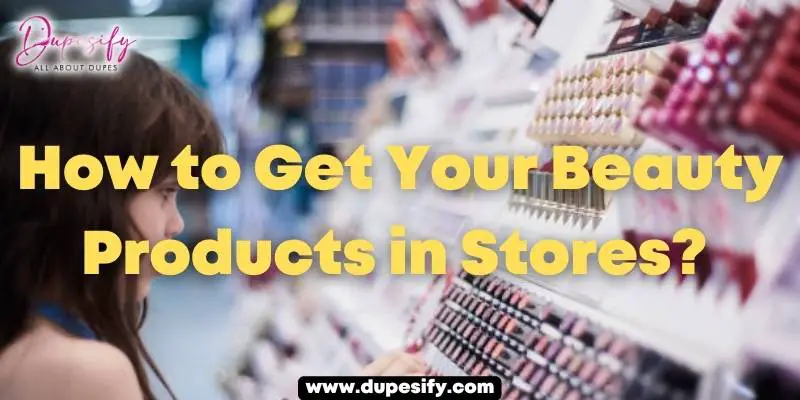Launching a beauty product is exciting, but reaching customers is challenging. So, How to Get Your Beauty Products in Stores? I learned that one of the best ways to increase visibility and sales is by getting your beauty products in stores. However, this can be daunting if you don’t know where to start.
Having your products in stores can significantly increase your brand’s visibility and credibility. It can help build trust with potential customers. But there are challenges you may face along the way, such as finding the right retailers, meeting their requirements, and standing out from the competition.
This article will provide information on how to get your beauty products in-store. I’ll show you actionable tips and strategies to help you get your beauty products in stores and make your brand successful. I hope in the end you will get benefited.
How to Get Your Beauty Products in Stores?
This is the right place for you if you want to know how to get your beauty products and makeup dupes in stores. Here in this, we will show some potential and actionable tips.
Researching Retailers
Researching retailers is one of the most critical steps when getting your beauty products in stores. Not all retailers will be a good fit for your brand, so it’s essential to do your homework to find the ones that align with your values and target audience. Hire a product tester to get honest feedback before putting everything in retail.
- Find Retailers
The first step in researching retailers is to find ones that align with your brand’s values and target audience. For example, if your products are all natural and eco-friendly, you may look for retailers prioritizing sustainability and carrying similar products.
- Identify Retailers
Another way to research retailers is to look for similar products to yours. This can help you identify stores more likely to be interested in your products. You can start by visiting competitors’ websites or social media pages to see where their products are sold.
- Learn About Retailers
Once you’ve identified potential retailers, learning about their requirements for accepting new products is essential. This can include minimum order quantities, packaging requirements, and pricing guidelines. You can usually find this information by contacting them directly.
Crafting a Compelling Brand Story
Having a solid brand story can be a powerful tool when getting your beauty products in stores. A brand story is a narrative that captures the essence of your brand and communicates it to customers and retailers. And try social media marketing for brand awareness. Go for the beauty and fashion photoshoot and introduce your products to the people.
Importance of a Strong Brand Story
A strong brand story can help differentiate your brand from competitors and build a connection with customers and retailers. A compelling story can create an emotional connection and make your brand more memorable. When customers and retailers can relate to your brand story, it can help build trust and loyalty.
Elements of a Brand Story
- Your brand’s origin story
This is the story of how your brand came to be and what inspired you to create it.
- Your brand’s values
This includes your brand’s mission, vision, and values.
- Your brand’s personality
This is the tone and style of your brand and how you want your brand to be perceived by customers and retailers.
Incorporating Brand Story
Once you’ve crafted a compelling brand story, it’s essential to incorporate it into your marketing materials and pitches to retailers. This can include your website, social media pages, packaging, and sales pitches.
When crafting your pitch to retailers, highlight how your brand story sets you apart from competitors and why your products are a good fit for their stores. And before everything, learn how to invest in fashion and beauty products.
Building Relationships with Retailers
As a business owner in the retail industry, building strong relationships with retailers is critical to your success. These relationships can help you access new markets, increase sales, and build your brand’s reputation.
- Networking at Industry Events and Trade Shows
Industry events and trade shows are excellent opportunities to connect with retailers. Retailers typically attend these events for new products and suppliers to add to their inventory. Attending these events lets you showcase your products and meet with potential retail partners face-to-face.
- Sending Samples to Retailers
Another effective way to build relationships with retailers is by sending them samples of your products along with a personalized note. This approach shows retailers that you’re interested in working with them precisely and that you value their business.

- Following Up with Retailers
Finally, following up with retailers is essential to building long-term relationships. Whether you’ve met with them at an industry event, sent them samples, or had a previous conversation, following up shows that you’re committed to working with them and value their time and input.
Prepare for Meetings with Retailers
As a business owner in the retail industry, preparing for meetings with retailers is a critical part of building successful partnerships. These meetings are an opportunity to showcase your products, build relationships, and negotiate deals.
- Bringing Samples
One of the most important things to do when preparing for a meeting with a retailer is to bring samples of your products. This allows the retailer to see, touch, and test your products. Additionally, you should bring relevant marketing materials highlighting your product’s unique features and benefits.
- Articulating Why Products Would be a Good
In addition to showcasing your products, you should be prepared to articulate why they would be a good fit for the store. This requires a deep understanding of the retailer’s target market, branding, and product mix. Research the store’s inventory and identify gaps or opportunities where your products can add value.
- Being Professional
It’s essential to be professional and authentic in meetings with retailers. This means dressing appropriately, being punctual, and clearly understanding the retailer’s needs. It’s also important to be genuine in your interactions. Building relationships with retailers requires trust, honesty, and learning about Big Data and other necessary retail-related knowledge.
Being Flexible and Open to Feedback
As a business owner, being flexible and open to feedback is critical to building successful relationships with retailers. This means being willing to adapt to retailers’ requirements for products or packaging and showing a commitment to working with them to make your products successful.
- Adapting to Retailers’ Requirements
One of the most important things you can do to be flexible and open to feedback is to adapt to retailers’ requirements for products or packaging. This could include changes to the design, materials, or size of your products or adjustments to the packaging to meet specific retailer requirements.
- Showing Commitment
Another effective strategy for being flexible and open to feedback is to commit to working with retailers to make your products successful. This means being responsive to their feedback and taking proactive steps to address any issues or concerns they may have. When retailers provide feedback, it’s essential to take it seriously and address it promptly.
Frequently Asked Question(FAQs)
Are Beauty Stores Profitable?
Yes, beauty stores can be profitable. However, profitability depends on various factors, such as the location, the size of the store, the product mix, pricing strategies, and customer demand.
Who Buys More Beauty Products?
As both men and women buy beauty products, but women tend to buy more beauty products overall. However, there has been a recent increase in men buying beauty products, especially in categories such as skincare and haircare.
Are Beauty Products in Demand?
Yes, beauty products are in demand. The global beauty industry is a multi-billion dollar industry that grows yearly. Beauty products remain popular among consumers with an increasing focus on self-care and wellness, along with new trends and product innovations.
Conclusion
I hope you now know how to Get Your Beauty Products in Stores. We’ve explored several effective strategies for building successful relationships with retailers. These strategies include networking at industry events and trade shows, sending samples to retailers, following up, preparing for meetings, being flexible and open to feedback, and showing a commitment to working to make products successful.
